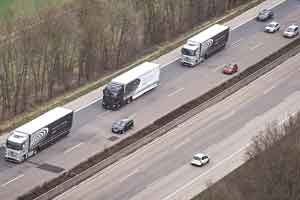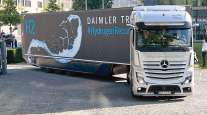Daimler's Autonomous Platoon Debuts on Germany's Autobahn

This story appears in the March 28 print edition of Transport Topics.
DÜSSELDORF, Germany — Daimler Trucks demonstrated what it called the next milestone in autonomous driving by running a three-truck platoon on a public stretch of the autobahn.
Daimler used the March 21-22 event here, attended by more than 300 journalists and guests from 36 countries, to expand upon its vision of how connectivity will continue to revolutionize all aspects of the supply chain, while drawing global attention to the European Truck Platooning Challenge, featuring six of the continent’s truck manufacturers.
“Connected trucks will have a huge impact. They will transform transportation completely,” said Wolfgang Bernhard, head of Daimler’s global truck and bus division. “And I promise, when we look back in 10 years we’ll recognize this was the turning point.”
ANALYSIS: Trucks make everyone smarter in Bernhard's connected vision
PHOTO GALLERY: Scenes from Dusseldorf
MORE VIDEO FROM DAIMLER: Platooning demo | Emergency braking demo | Lane change demo
While the event mainly focused on that transformation, the centerpiece was the live platoon demo. Using live video feeds to communicate with drivers of three heavy-duty Mercedes-Benz Actros trucks, Sven Ennerst, head of truck product engineering and global procurement, guided attendees through the process of trucks going from manual driving to electronic linkage and traveling in autonomous mode as closely as 15 meters apart (49 feet).
“This has important advantages,” Ennerst said. “It improves aerodynamics. Fuel economy and greenhouse-gas emission are reduced by 7% for the entire platoon.”
The trucks use Highway Pilot Connect, an advanced version of the Highway Pilot technology that was featured in the Future Truck concept vehicle in Germany in 2014 and the Freightliner Inspiration truck at the Hoover Dam last May.
Highway Pilot Connect by @Daimler_CV @TransportTopics #SFT pic.twitter.com/Bki2f4FExy — Neil Abt_TT (@NeilAbt) March 21, 2016
During the demonstration, when the lead vehicle was ready to create the platoon, it asked the second vehicle via dedicated short-range communication to join, producing yellow blinking lights that became visible to all motorists. At the touch of a button, the second truck was linked and the process repeated from the second to the third vehicle. Daimler said as many as 10 trucks could be in a platoon, and each has access to a video link of what the lead truck sees.
Once linked, the drivers removed their hands from the steering wheels and feet from the pedals. After a few moments, as they approached a highway junction, the vehicles automatically adjusted to 50 meters apart, before returning to 15 meters once the conditions were suitable.
Likewise, when a car that was part of the demonstration made its way between the back two trucks, the third one slowed to create additional room, though the first two in the platoon remained at 15 meters.
That experience was duplicated during test drives for journalists along the same stretch of road the next day.
Upon entering the autobahn, there was a steady stream of traffic, and almost all other drivers unlikely aware of what was taking place. On one occasion, the lead driver began the platooning process but briefly called it off because conditions were not ideal.
Even when not actively driving, the truckers remained focused on surroundings. When the lead vehicle changed lanes, the others were notified with a beep and moved over manually. During that time, Highway Pilot Connect remained engaged and once the maneuver was completed the vehicle continued in autonomous mode.
Martin Zeilinger, head of advanced engineering, said a platooning truck can begin to brake in an emergency in 0.1 second, while it could be as much as 1.4 seconds for humans. He also explained that German trucks must be shown to be able to stop in less than 15 meters, which ensures a safe distance for the platoons.
Several executives were quick to attempt to alleviate concerns about the close following distance, which is key to the fuel-economy gains through reduced aerodynamic drag. They also stressed the security of vehicle-to-vehicle messaging, comparing it with that of banking transactions.
Though company officials declined to speculate when a similar platooning demonstration may be heading to North America, these Daimler trucks will be taking part in the European Truck Platooning Challenge on March 29-April 6. Along with Volvo, Scania, DAF, MAN and Iveco, each company will platoon on public roads from different parts of Europe and meet in Rotterdam, Netherlands.
Organizers said the objective is to accelerate the development of convoy- driving corridors within Europe, to increase cross-border cooperation and to pave the way for European Union legislative changes.
Ennerst noted that a number of U.S. states have been “more progressive” than European nations in adjusting legislation for following distances required for platooning tests to take place.
 Ennerst by Daimler AG
Ennerst by Daimler AGMeanwhile, Stephan Buchner, president of Mercedes-Benz Trucks, said further enhancements with Daimler’s Highway Pilot Connect will be unveiled this fall in conjunction with the IAA Commercial Vehicles Show in Hanover, Germany.
The event included Matt Pfaffenbach, director of telematics of Daimler Trucks North America. He was joined by Brett Brinton, president of Zonar Systems, which helped develop Virtual Technician and calls DTNA a minority owner.
Brinton said the demo showed him platooning was “a more practical application of an autonomous vehicle,” and thought the event could “raise awareness” in the United States and help “start the discussion among all [truck] brands.” demo. Using live video feeds to communicate with drivers of three heavy-duty Mercedes-Benz Actros trucks, Ennerst guided attendees through the process of trucks going from manual driving to electronic linkage and traveling in autonomous mode as closely as 15 meters apart (49 feet).
Brett Brinton of @zonarsystems at the @Daimler_CV event talking about telematics partnership with @DaimlerTrucksNA pic.twitter.com/2Co6uhCRhC — Neil Abt_TT (@NeilAbt) March 21, 2016




